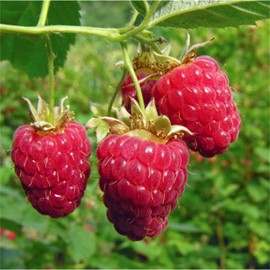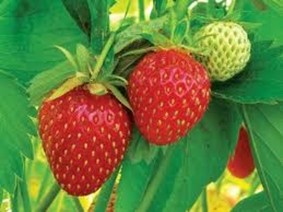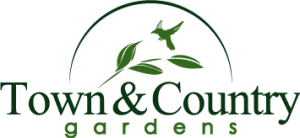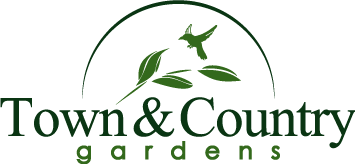Fruits Small Varieties
Fruits Small Varieties
| What You’ll Need: | |
| Essential Items | Desirable Items |
| Soil Enhancer | T&C Fruit & Flower Food |
| Soil Sulfur | Save-a-Tree |
| Root Stimulator | Bird Netting |
| Pruners |
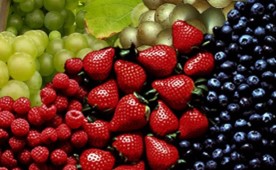
Blueberry – Requires an acidic soil. Amend with soil sulfur. Also prefers moist soil.
Northblue. Fruit is dark blue, large and attractive with good flavor. Glossy, dark green leaves turn bright red in fall. Self-fruitful, but will get a larger crop with two different varieties. Grows 20-30 inches tall. (Zone 4)
Pink Lemonade. Pinkish-white, bell-shaped blooms in the spring are followed by pale green fruit that turns deep pink for harvest. Glossy and firm, the fruit has a mild sweet flavor. Leaves turn orange and red in the fall. Grows 4-5’ tall and 4-5’ wide. (Zone 4)
Patriot- Fruit is very large, and firm. Berry is formed on tight clusters and it tends to be flatter than other cultivars. Ripens early. Excellent flavor. Bush is upright, open and vigorous. Dark green foliage in summer, and fiery orange fall colors. (Zone 4)
Bush Cherry
Nanking. Tasty red fruits 1/3”. Ripens June-July. Makes excellent jams and jellies or may be eaten fresh. Wildlife also love the fruit. Showy white flowers with a pink blush appear in early spring. Grows to 8-10’ tall. Makes a great hedge. (Zone 2)
Currant
Red Lake. Clusters of large bright red berries borne on 2-3 yr. old wood. Semi-erect and vigorous. Very productive. Fruits are good for jams and jellies. Grows 3-6 feet tall. (Zone 3)
Gooseberry
Pixwell. Fewer thorns than most. Makes delicious pies, tasty preserves. Very hardy, do well in average soil. Needs little or no feeding or special care, lasts years and years. Self- fruitful and should bear the first year after planting. Mature height 3-4 ft., width 3-4 ft. Plant 5 ft. apart. (Zone 3)
Small Fruit Planting Chart
|
Fruit |
Planting Distance* | When
Harvest Begins |
Years
to full crop |
Life of Plants |
Mature Height |
Estimated
Yield per plant** |
Suggested No.
of plants for family of 5 |
|
| Between
Rows |
Between
Plants |
|||||||
| (in feet) | (in feet) | (in years) | (years) | (in feet) | (annual) | |||
| Asparagus | 05-Mar | 1 | 1 | 3 | 20+ | 4 | 1/4-1/2 pound | 25-20 |
| Rhubarb | 3-5 | 2 | 1 | 2 | 20+ | 3 | 10 pounds | 4-6 |
| Strawberries (hills) | 1 to 1-1/2 | 1 to 1/2 | 60 days | – | 1-3 | 1 | 1/2 quart | 100 |
| Strawberries (matted) | 3-4 | 1 to 1/2 | 1 | 1 | 3-8 | 1 | 1/2-1 qt. Per | 150 |
| Currants | 6-8 | 4 | 2 | 4 | 12-15 | 3-4 | 3-4 quarts | 4-6 |
| Gooseberries | 6-8 | 4 | 2 | 4 | 12-15 | 3-4 | 4-5 quarts | 4-6 |
| Raspberries Red | 6-8 | 1-2 | 1 | 3 | 8-15 | 4-5 | 1 1/2 quarts | 25-50 |
| Everbearing | 8 | 2-3 | 1/2 | 2 | 8-15 | 4-5 | 1 quart-summer | 25-50 |
| 1/2 quart-fall | 25-50 | |||||||
| Raspberries Black | 6-8 | 2 1/2 | 1 | 3 | 8-10 | 4-5 | 1 quart | 25-50 |
| Blackberries Erect | 6-8 | 3 | 1 | 2 | 10-12 | 4-5 | 1 quart | 25-50 |
| Trailing | 6-8 | 6-10 | 1 | 2 | 8-10 | 6-8 | 4-10 quarts | 8-10 |
| Blueberries | 8-10 | 6/8 | 2 | 5 | 20+ | 6-10 | 3-4 quarts | 8-10 |
| Grapes | 8-10 | 8/10 | 3 | 5 | 20+ | 6 | 1/4-1/2 bushel | 5-10 |
* Minimum Suggested Spacing
** At full bearing age, with good care.
